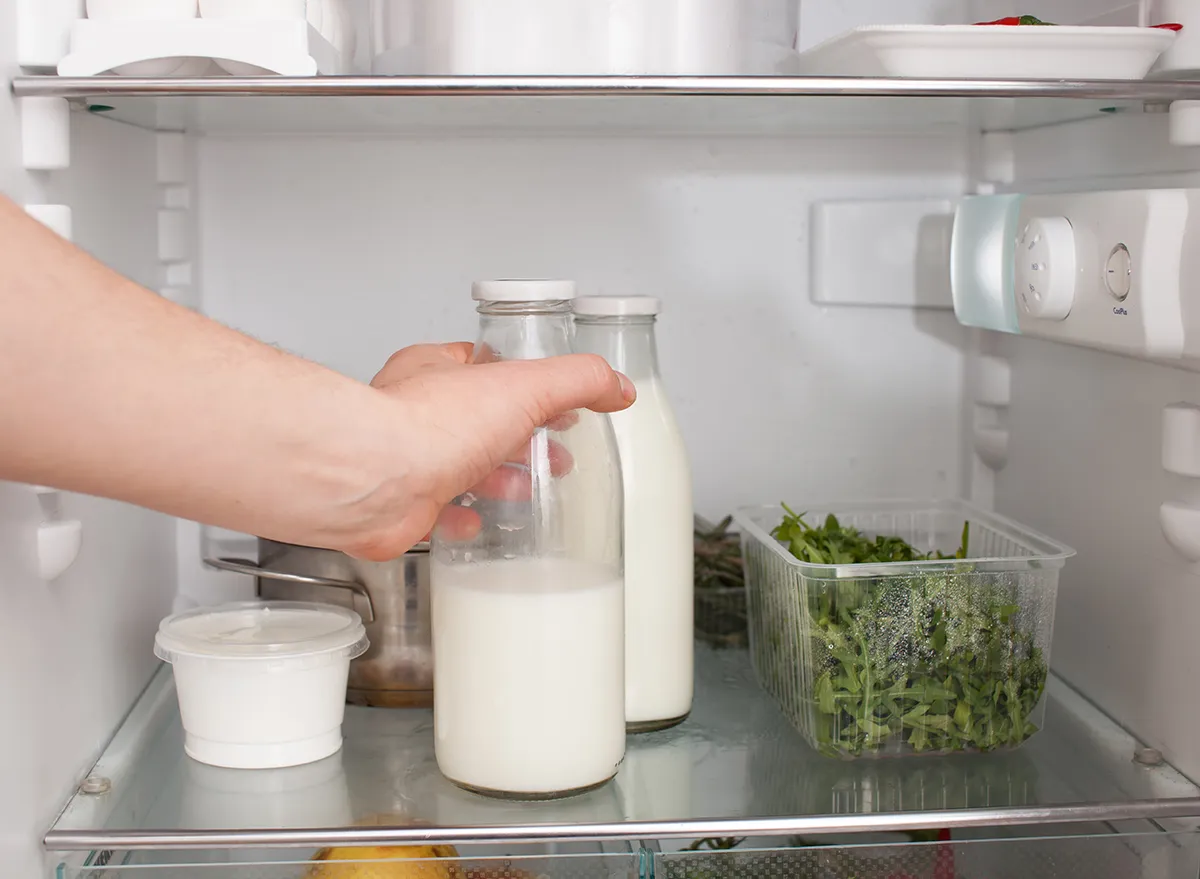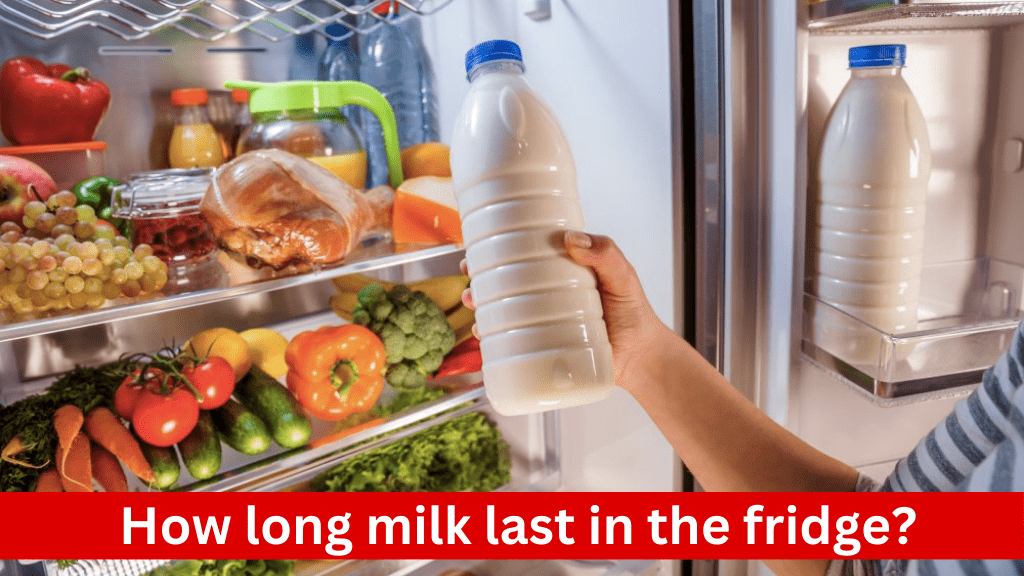Milk is a staple in many households, used in everything from cereal to baking. But how long does it actually last in the fridge before it goes bad? In this comprehensive guide, we’ll explore the factors that affect milk’s shelf life, how to properly store it, and how to tell if it’s gone bad.
Factors Affecting Milk’s Shelf Life

When it comes to determining how long milk lasts in the fridge, several factors come into play:
1. Type of Milk:
- The type of milk, whether it’s whole milk, reduced-fat milk, skim milk, lactose-free milk, or alternative milk varieties like almond or soy milk, can affect its shelf life.
- Milk with higher fat content, such as whole milk, tends to spoil more quickly than lower-fat options due to its higher susceptibility to bacterial growth.
- Additives and preservatives may also extend the shelf life of certain milk products, such as lactose-free milk or ultra-pasteurized milk.
2. Packaging:
- The packaging material and design play a significant role in preserving milk’s freshness.
- Cartons, plastic jugs, and glass bottles are common packaging options for milk, each offering different levels of protection against light, air, and contaminants.
- Opaque or light-blocking packaging helps shield milk from light exposure, which can cause oxidation and off-flavors.
- Airtight seals and sturdy packaging help prevent contamination and maintain the milk’s integrity during storage and transportation.
3. Storage Temperature:
- Temperature control is critical for extending the shelf life of milk.
- Refrigeration slows down the growth of bacteria and other microorganisms that can cause milk to spoil.
- Storing milk at temperatures between 38°F and 40°F (3°C to 4°C) in the main body of the refrigerator is recommended to maintain its freshness.
- Fluctuations in temperature, such as exposure to warmer temperatures during transportation or storage, can accelerate milk spoilage.
4. Handling:
- Proper handling practices are essential for preserving milk’s quality and safety.
- Contamination from dirty utensils, countertops, or hands can introduce harmful bacteria into the milk, leading to spoilage.
- Tightly sealing milk containers after each use helps prevent exposure to air and reduces the risk of contamination.
- Avoiding cross-contamination with other foods, especially those with strong odors or flavors, helps maintain the milk’s flavor and aroma.
5. Processing Methods:
- The processing methods used to produce and package milk can impact its shelf life.
- Pasteurization, which involves heating milk to kill harmful bacteria, helps extend its shelf life and improve safety.
- Ultra-pasteurization, a more intense heat treatment, further extends the shelf life of milk by eliminating more bacteria and spores.
- Homogenization, which breaks down fat globules in milk to create a uniform texture, can also affect its stability and shelf life.
How to Store Milk Properly

1. Temperature Control:
- Milk should be stored at a consistent temperature to slow down bacterial growth and maintain its quality.
- The ideal temperature range for storing milk is between 38°F and 40°F (3°C to 4°C).
- Place milk containers in the main body of the refrigerator rather than the door, as the temperature fluctuates less in this area.
2. Original Packaging:
- It’s best to keep milk in its original packaging to preserve its freshness and prevent exposure to light and air.
- Milk containers are designed to provide adequate protection against light and contaminants.
- Avoid transferring milk to different containers unless necessary, as this can increase the risk of contamination and affect quality.
3. Sealing and Closure:
- Ensure that the milk container is tightly sealed after each use to minimize exposure to air and odors.
- Proper sealing prevents moisture loss and maintains the milk’s flavor and aroma.
- Check for any leaks or damage to the packaging, as compromised seals can lead to spoilage.
4. Avoiding Light Exposure:
- Light exposure can accelerate the degradation of milk and cause off-flavors and odors.
- Store milk away from direct sunlight and sources of artificial light, such as fluorescent or LED bulbs.
- Opt for opaque or light-blocking containers to further protect milk from light exposure.
5. Proper Placement in the Refrigerator:
- Position milk containers away from foods with strong odors or flavors to prevent cross-contamination.
- Store milk on shelves rather than on the refrigerator door, as the door is subjected to more temperature fluctuations.
- Avoid overcrowding the refrigerator to allow for adequate air circulation around the milk containers.
6. Monitoring Expiry Dates:
- Pay attention to the expiration date or use-by date printed on the milk container.
- Consume milk before the expiration date for optimal freshness and quality.
- Rotate milk containers in the refrigerator to use older stock first and minimize waste.
7. Regular Inspection:
- Periodically inspect milk for signs of spoilage, such as unusual odors, off-flavors, or changes in texture.
- Discard any milk that appears discolored, curdled, or has an off odor, as these are indicators of spoilage.
- Trust your senses; if milk looks or smells questionable, it’s better to err on the side of caution and discard it.
How Long Does Milk Last in the Fridge?

1. Unopened Milk:
- The shelf life of unopened milk depends on various factors, including the type of milk and its fat content.
- Whole milk typically lasts for about 5 to 7 days past its printed date when refrigerated properly.
- Reduced-fat and skim milk varieties may last slightly longer, generally up to 7 days beyond the expiration date.
- Non-fat and lactose-free milk variants can often last even longer, sometimes up to 7 to 10 days beyond the printed date.
2. Opened Milk:
- Once a milk container is opened, its shelf life decreases due to exposure to air and potential contamination.
- Regardless of the type, opened milk typically remains fresh for around 4 to 7 days when stored in the refrigerator.
- Proper sealing of the container after each use is essential to minimize exposure to air and maintain freshness.
- It’s important to adhere to the recommended storage guidelines and consume opened milk within the specified timeframe for optimal quality and safety.
3. Room Temperature Exposure:
- Leaving milk at room temperature for an extended period can significantly reduce its shelf life and compromise its safety.
- According to the FDA, milk should not be left unrefrigerated for more than two hours to prevent the growth of harmful bacteria.
- Exposure to higher temperatures accelerates bacterial growth and increases the risk of spoilage and foodborne illness.
- Always return milk to the refrigerator promptly after use to maintain its freshness and safety.
4. Storage Conditions:
- Proper storage conditions are crucial for preserving the quality of milk in the fridge.
- Milk should be stored at temperatures between 38°F and 40°F (3°C to 4°C) to slow down bacterial growth and maintain freshness.
- Placing milk containers in the main body of the refrigerator, away from the door and other temperature fluctuations, helps optimize shelf life.
- Avoiding exposure to light and strong odors further extends the milk’s freshness and prevents off-flavors.
5. Sensory Evaluation:
- As milk approaches its expiration date, it’s important to conduct sensory evaluations to assess its quality.
- Signs of spoilage include a sour or off odor, abnormal texture such as clumping or curdling, and changes in color.
- Trust your senses; if milk appears or smells questionable, it’s best to discard it to avoid the risk of consuming spoiled milk.
How to Tell If Milk Has Gone Bad

1. Odor:
- One of the most reliable indicators of spoiled milk is a sour or off odor.
- Fresh milk typically has a mild, slightly sweet scent. If you detect a strong, unpleasant odor resembling sourness or fermentation, it’s likely that the milk has begun to spoil.
- Trust your sense of smell; if the milk smells off or foul, it’s best to discard it.
2. Appearance:
- Visually inspect the milk for any changes in appearance, such as discoloration or unusual texture.
- Fresh milk should have a uniform, creamy color. If you notice any separation, curdling, or clumps in the milk, it may be spoiled.
- Mold growth on the surface of the milk or inside the container is a clear indication of spoilage and should prompt immediate disposal.
3. Texture:
- Texture changes can also signal that milk has gone bad.
- Spoiled milk may develop a slimy or chunky consistency, indicating the presence of bacteria or microbial growth.
- Run a spoon through the milk or gently shake the container to assess its texture. If you observe any abnormalities, such as lumps or curds, the milk should not be consumed.
4. Taste:
- While taste is often the last sense used to determine milk spoilage, it can provide valuable information.
- Fresh milk has a clean, mild flavor with a slightly sweet taste. If the milk tastes sour, tangy, or unpleasant, it has likely soured and should be discarded.
- Avoid consuming milk with off-flavors or a rancid taste, as it may pose health risks.
5. Sensory Evaluation:
- Conduct a comprehensive sensory evaluation of the milk by using multiple senses to assess its quality.
- Start by examining the milk’s appearance and smelling it to detect any off odors.
- Check the texture by observing its consistency and gently swirling or shaking the container.
- Finally, taste a small amount of the milk to confirm its flavor and ensure that it hasn’t turned sour or rancid.
6. Trust Your Instincts:
- When in doubt, trust your instincts and err on the side of caution.
- If the milk exhibits any signs of spoilage or you feel uncertain about its safety, it’s best to discard it rather than risking consumption.
- Consuming spoiled milk can lead to foodborne illness and gastrointestinal discomfort, so it’s essential to prioritize food safety.
Conclusion
Understanding how long milk lasts in the fridge and how to properly store it can help minimize food waste and ensure you always have fresh milk on hand. By following storage guidelines and paying attention to expiration dates, you can enjoy your milk safely and deliciously.

